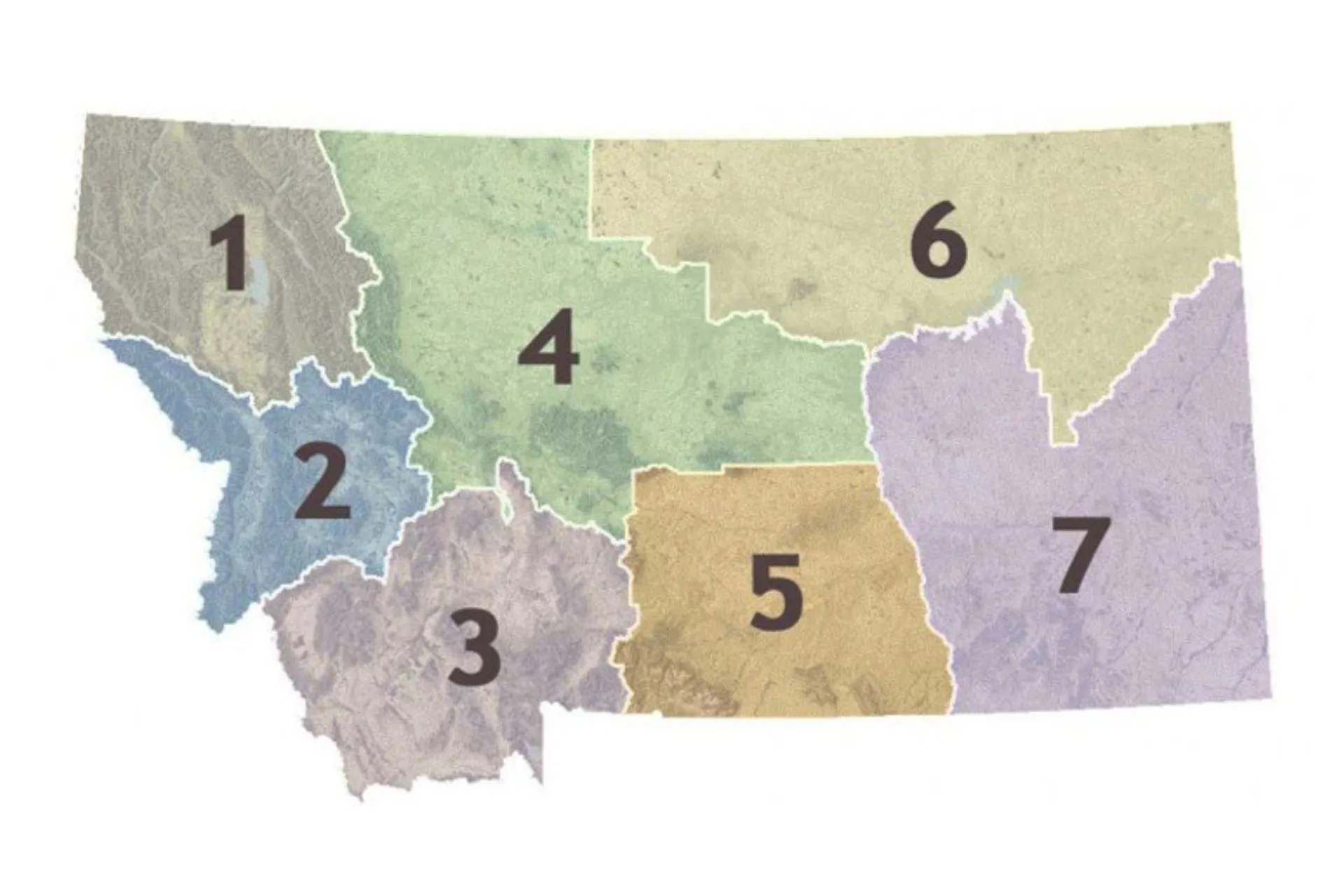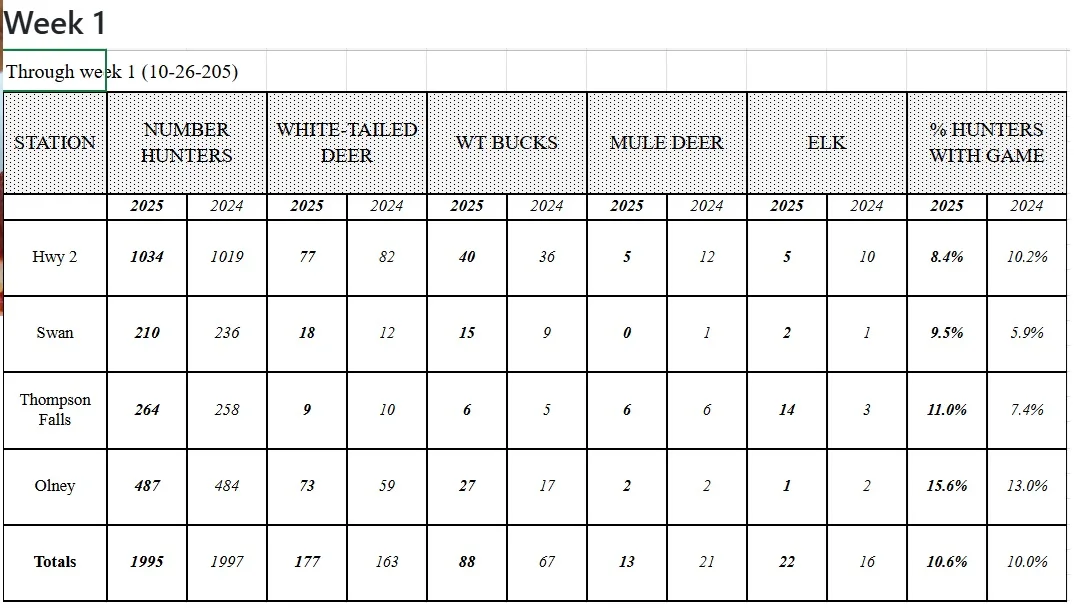Montana Outdoor

General deer and elk hunting season opens strong in northwest Montana
KALISPELL — Montana’s general deer and elk hunting season opened last weekend with nearly 2,000 hunters stopping at Montana Fish, Wildlife & Parks Region 1 check stations, reporting a slightly higher percentage of success compared to last year.
The check station results from the opening weekend show increased overall harvests of white-tailed deer and elk across the region over last year, while mule deer numbers were down.
The 2025 general season runs through Nov. 30.
Check stations are open on weekends during general season from 10 a.m. to approximately 1.5 hours past sunset. The northwest Montana stations are located at U.S. Highway 2 West of Kalispell, Montana Highway 83 north of Swan Lake, Highway 200 west of Thompson Falls, and Highway 93 near Olney.
Hunters must stop at any check station they encounter whether they harvested an animal or not. The counts at the stations represent a sampling of the harvest and do not represent the complete number of animals taken.
A table linked below summarizes the opening weekend results at northwest Montana check stations.
Chronic Wasting Disease
Hunters play an important part in helping FWP learn where chronic wasting disease (CWD) is and how it spreads.
When hunters have their harvested deer, elk and moose tested for CWD, they provide key insights into the effectiveness of CWD management, the disease’s prevalence and its presence.
Hunters can have their animals sampled at CWD sampling stations or most FWP offices. Hunters can also collect the samples themselves, fill out the online hunter submission form and mail the samples to the Wildlife Health Lab in Bozeman.
For info on how to self-submit samples and a list of CWD sampling station locations, visit https://fwp.mt.gov/conservation/chronic-wasting-disease/
FWP hosting CWD sampling clinic on Oct. 30
FWP is hosting a sampling clinic at its Kalispell office on Thursday, Oct. 30 to help hunters learn how to collect lymph nodes for testing. The clinic will be from 5-6 p.m. with staff available to help teach hunters how to self-submit samples. Hunters can bring a recently harvested deer or elk head or FWP will have some heads available to practice on.
CWD Testing
CWD testing is voluntary in most places in Montana.
All hunters in Hunting District 170 are encouraged to get their harvested deer and elk tested for CWD.
There are mandatory testing requirements for tags associated with CWD management near Libby. Testing is required for all animals harvested using the Deer B License 199-20 in HDs 100, 103 and 104, or Deer Permit 103-50 in HD 103.
FWP strongly recommends that hunters receive a negative CWD test result before bringing their deer, elk or moose to a meat processor or donating it to a foodbank.
If the animal tests positive for CWD, FWP will advise the hunter on proper carcass and meat disposal and give instructions on how to request a replacement license.
In northwest Montana, here’s how you can get your animal sampled this fall:
General Deer & Elk Season
- Hunters may self-submit samples
- Visit the Libby CWD Sampling Station, located at the Montana Department of Transportation shop on US Hwy 2. It will be open Saturdays, Sundays & Mondays, 10 a.m. – dusk.
- Visit a game check station open on weekends
- Visit the Region 1 office in Kalispell (490 N. Meridian) during business hours, Monday–Friday.
Heritage Muzzleloader
- Hunters may self-submit samples
- Schedule an appointment with the Libby office at 406-293-4161 (ext. 209)
- Visit the Region 1 office in Kalispell (490 N. Meridian) during business hours, Monday–Friday
Learn more about CWD at https://fwp.mt.gov/conservation/chronic-wasting-disease/
Carcass Disposal
Carcass parts, such as brain, eyes, spleen, lymph glands, and spinal cord material, should be left at the kill site when possible. If the animal is transported for taxidermy or meat processing, the brain and spinal tissue must be bagged and disposed of in a Class II landfill.
A carcass may be transported within the state regardless of where it was harvested if the carcass parts are disposed of in a landfill after butchering and processing.
Dumping carcasses is illegal, unethical, and can spread diseases, including chronic wasting disease. This requirement applies to all deer, elk, and moose carcasses wherever in the state they are harvested by hunters or as vehicle-killed salvage.
For a map of carcass disposal sites, click here.
Northwest Montana (Region 1) Hunting Season Reminders
- Hunters should plan ahead and review the regulations for each hunting district they plan to hunt. When reading the regulation booklet, make sure to review the far right column titled, “Opportunity Specific Details and/or Restrictions.”
- All hunters planning to access the Flathead Ridge Ranch Block Management Area off U.S. Highway 2 West between Kalispell and Libby must obtain a free permission card for the season. The permission card must be displayed from the rearview mirror of every hunter’s vehicle while on the property. Only one card per vehicle is required but each hunter’s name within the vehicle must be on the slip. Hunters can acquire these permission cards from the FWP office in Kalispell or at sign-in boxes throughout Flathead Ridge Ranch BMA. These cards serve as proof of permission to hunt on the property for the entire general season. Similar to other Block Management areas across the state, FWP will use the permission cards to track hunting pressure and gather important feedback on the hunting season.
- Many private lands that were historically owned by corporate timber companies have changed ownership, and hunters should review the Block Management Program for to view available public access opportunities and restrictions on private lands. Visit https://fwp.mt.gov/hunt/landownerprograms/block-management
- Hunters should “Be Bear Aware” and properly store food and carcasses. Hunters should avoid hanging carcasses near houses or garages. Carcasses should be suspended at least 10 feet above the ground and 4 feet out from any upright support. Hunters are encouraged to carry bear spray and know how to use it. More food storage and safety information are available on the FWP website at https://fwp.mt.gov/conservation/wildlife-management/bear/be-bear-aware
- A recent outbreak of epizootic hemorrhagic disease (EHD) is causing numerous mortalities in white-tailed deer across western Montana. Carcasses tend to be concentrated around water sources, in particular, and can be creating an attractant for bear. Both grizzly and black bears are currently eating excessively to prepare for hibernation. Deer can be a nice boost for their hungry appetite, but also a potential place for a negative interaction between recreation and wildlife. Hunters should be aware of potential carcasses attracting bears.
Northwest Montana Game Check Station Results
